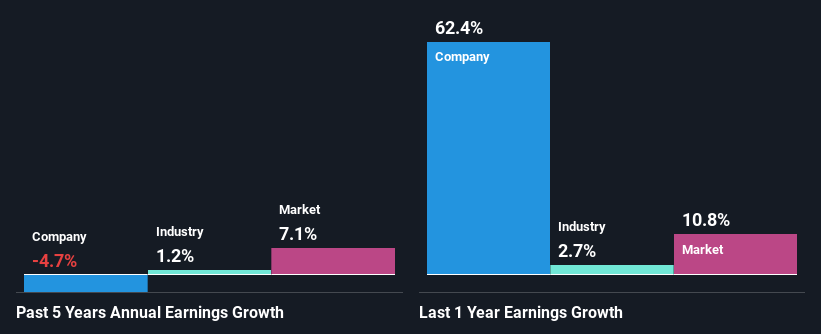Stock Analysis
- South Africa
- /
- Food
- /
- JSE:TBS
Does The Market Have A Low Tolerance For Tiger Brands Limited's (JSE:TBS) Mixed Fundamentals?

With its stock down 12% over the past three months, it is easy to disregard Tiger Brands (JSE:TBS). It seems that the market might have completely ignored the positive aspects of the company's fundamentals and decided to weigh-in more on the negative aspects. Stock prices are usually driven by a company’s financial performance over the long term, and therefore we decided to pay more attention to the company's financial performance. In this article, we decided to focus on Tiger Brands' ROE.
Return on Equity or ROE is a test of how effectively a company is growing its value and managing investors’ money. In other words, it is a profitability ratio which measures the rate of return on the capital provided by the company's shareholders.
See our latest analysis for Tiger Brands
How Do You Calculate Return On Equity?
Return on equity can be calculated by using the formula:
Return on Equity = Net Profit (from continuing operations) ÷ Shareholders' Equity
So, based on the above formula, the ROE for Tiger Brands is:
17% = R2.9b ÷ R17b (Based on the trailing twelve months to March 2023).
The 'return' is the yearly profit. That means that for every ZAR1 worth of shareholders' equity, the company generated ZAR0.17 in profit.
What Has ROE Got To Do With Earnings Growth?
Thus far, we have learned that ROE measures how efficiently a company is generating its profits. We now need to evaluate how much profit the company reinvests or "retains" for future growth which then gives us an idea about the growth potential of the company. Assuming everything else remains unchanged, the higher the ROE and profit retention, the higher the growth rate of a company compared to companies that don't necessarily bear these characteristics.
A Side By Side comparison of Tiger Brands' Earnings Growth And 17% ROE
On the face of it, Tiger Brands' ROE is not much to talk about. Although a closer study shows that the company's ROE is higher than the industry average of 13% which we definitely can't overlook. But then again, seeing that Tiger Brands' net income shrunk at a rate of 4.7% in the past five years, makes us think again. Remember, the company's ROE is a bit low to begin with, just that it is higher than the industry average. So that could be one of the factors that are causing earnings growth to shrink.
However, when we compared Tiger Brands' growth with the industry we found that while the company's earnings have been shrinking, the industry has seen an earnings growth of 1.2% in the same period. This is quite worrisome.

The basis for attaching value to a company is, to a great extent, tied to its earnings growth. The investor should try to establish if the expected growth or decline in earnings, whichever the case may be, is priced in. By doing so, they will have an idea if the stock is headed into clear blue waters or if swampy waters await. Is TBS fairly valued? This infographic on the company's intrinsic value has everything you need to know.
Is Tiger Brands Using Its Retained Earnings Effectively?
With a high three-year median payout ratio of 62% (implying that 38% of the profits are retained), most of Tiger Brands' profits are being paid to shareholders, which explains the company's shrinking earnings. With only very little left to reinvest into the business, growth in earnings is far from likely.
Moreover, Tiger Brands has been paying dividends for at least ten years or more suggesting that management must have perceived that the shareholders prefer dividends over earnings growth. Based on the latest analysts' estimates, we found that the company's future payout ratio over the next three years is expected to hold steady at 54%. As a result, Tiger Brands' ROE is not expected to change by much either, which we inferred from the analyst estimate of 17% for future ROE.
Summary
Overall, we have mixed feelings about Tiger Brands. Specifically, the low earnings growth is a bit concerning, especially given that the company has a respectable rate of return. Investors may have benefitted, had the company been reinvesting more of its earnings. As discussed earlier, the company is retaining a small portion of its profits. Having said that, looking at current analyst estimates, we found that the company's earnings growth rate is expected to see a huge improvement. To know more about the company's future earnings growth forecasts take a look at this free report on analyst forecasts for the company to find out more.
Valuation is complex, but we're here to simplify it.
Discover if Tiger Brands might be undervalued or overvalued with our detailed analysis, featuring fair value estimates, potential risks, dividends, insider trades, and its financial condition.
Access Free AnalysisHave feedback on this article? Concerned about the content? Get in touch with us directly. Alternatively, email editorial-team (at) simplywallst.com.
This article by Simply Wall St is general in nature. We provide commentary based on historical data and analyst forecasts only using an unbiased methodology and our articles are not intended to be financial advice. It does not constitute a recommendation to buy or sell any stock, and does not take account of your objectives, or your financial situation. We aim to bring you long-term focused analysis driven by fundamental data. Note that our analysis may not factor in the latest price-sensitive company announcements or qualitative material. Simply Wall St has no position in any stocks mentioned.
About JSE:TBS
Tiger Brands
Engages in the manufacture and sale of fast-moving consumer goods in South Africa.
Excellent balance sheet second-rate dividend payer.

